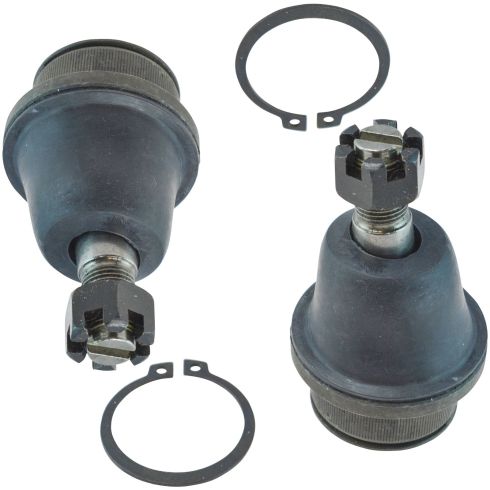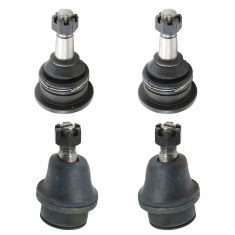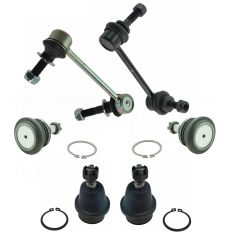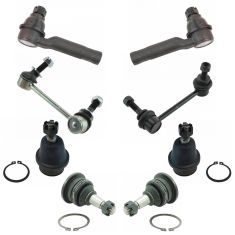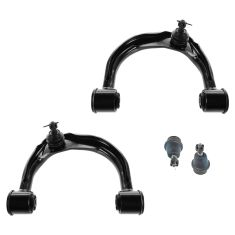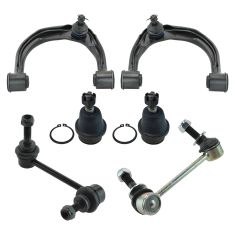Hey, friends, it's Len here at 1A Auto. Today I'm working on a 2007 Toyota FJ Cruiser, and I'm going to be replacing a lower ball joint. It's going to be fairly simple. I can do it. You can do it, too. If you need any parts, you can always check us out at 1AAuto.com thanks.
So, we've got our safety glasses on, hand protection. 21 millimeter socket. You can use a ratchet or an air gun, whatever you have access to. We're going to go ahead and loosen up these lug nuts. There we are. We'll continue on, take off all the lug nuts. And we'll get the wheel off. There we are. Remove the wheel, put it safely out of the way.
We're going to come over here. We're going to remove this cotter pin right here. This just locks in the nut so it can't come loose on you when you're driving down the road. If you have access to new cotter pins, that's always good. A lot of times when you remove them, they get kind of mangled. If you don't, well, I don't know. You do your booboo, but I would replace it if you have access.
Now, we're going to remove this nut right here. So, we've got our 19 millimeter, safety glasses, hand protection. I'm going to use my air gun on this. So here we go. This is what our nut looks like. This is called a castle nut or a slotted nut. Has all these slots up along the top. When you put this back on, you're going to line up the slot with the cotter pin hole. What I'm going to do with the nut now, I'm just going to turn it on a few threads.
Then I'm going to grab my hammer and I'm going to give the knuckle, which is this part right here, not the tie rod, a couple bonks. It's going to break it free. The reason for the nut is so it doesn't come swinging down, potentially hurt anybody. Since we're going to be replacing the tie rod, it really doesn't matter where you hit generally, it's just kind of a good habit to hit right on the knuckle. If you happen to hit up here or down there, it is what it is, I guess.
We're replacing the tie rod, so I'm not too worried about it, but if you weren't you'd want to definitely make sure you only hit on the knuckle. Pull that down. Now, let the tie rods off. We're going to remove these bolts right here. One here, one there. 19 millimeter. Safety glasses on. There's our two bolts. We'll set these aside. So now, we're just going to grab the knuckle area. We're just going to lift this up and slide it away just like this.
You don't want to pull it out away and towards you because you'll pull the axle and you'll separate your CV joints, which will be a big hassle. So now, I'm just going to use something as simple as a ratchet strap. And this is just to hold it away while I work. This gives us plenty of room to be able to do what we need to do. So now, you want to take out this cotter pin right here. Once you get this off, we're going to take off this nut.
Now, we're going to use a pickle fork and we're going to separate this lower part, which connects to your knuckle and to the ball joint. We're going to take that off of here. You just want to pay special attention to which way this is facing. You've got kind of this blocky area right here. And that just rubs right up against here. So when you go to turn your wheel, you can't keep turning forever. It stops you. It's a stopper. So, when you go to put this back on, you want to make sure that you don't have it, I don't know, somehow backwards, however somebody might do that, but whatever. Blocker hits up against here.
To move along, we'll get this cotter pin out of here and/or cut it. I'm going to be replacing the ball joint, so I'm really not worried about it. I'm just going to cut it off. 24 millimeter socket. Give it a couple bonks. Got our half-inch air gun. Here we go. We'll take that castle nut. Just put it on a few threads. Now, I'm going to use the pickle fork right in between here. Try to separate these two.
The reason for putting the nut back on is just so when this piece comes loose, it doesn't come down, hit me in the foot, the shin, anything like that. Safety first is the number one concern here at 1A Auto. Just going to set this so it's up against the bumper there. There we are, separated. You can see the difference. Take our nut back off of here. We'll set this out of the way.
So, I spun the knuckle. I've got to push towards the forward end of the vehicle, because the way that the clip is. I need to be able to grab onto either this ear or that ear. So pick whichever ear you want. Use a small pry bar, as long as it's got the punch end on it. And of course, a hammer. Safety glasses. You're just going to give it a couple of bonks, and it should want to work its way right off of there. It looks like it's starting to come off right here. I've got a nice separation, so I'm just going to grab onto it there.
At this point, it's probably going to come flying out, so safety glasses are definitely key. If you don't have safety glasses on, it's on you. There we are. Cool. For this I'm going to use my big fabulous hammer, and I'm going to give it a couple of whacks right up along top here. I'm going to be very careful to try not to hit my axle boot, my ABS unit, sway bar link, anything. The only thing I want to hit, right on top. So, let's give it a couple of loving bonks here and see how it goes.
All right. So now, what we're going to do, since this ball joint does not want to come out very easily ... I tried giving it a couple bonks, and it just really doesn't want to break free. We have a ball joint set that can also be used to remove these a lot of times, but none of the cups just happen to be the right size. So that makes it interesting. So now what I'm going to do is, I'm going to use a acetylene torch.
You may or may not have access to something like this. If you do, this is all we're going to do. I'm going to spark it up a little bit. Try to heat up along the edge here, right along where the ball joint and the lower control arm meet, and see if I can get some heat in there. And then, I'm going to go ahead and spray it with some lubricant. It's going to create some smoke at that point. And of course, I don't want to inhale the smoke, so I'll let the smoke dissipate before I continue.
So, here we go. Safety glasses, hand protection. Oops. All right. I'm going to be very careful not to heat up around this boot rubber. And of course, I don't want to mess up my ABS sensor, so I'm going to try to heat away from it. Just a couple squirts here. Let's try to give this a couple of loving bonks. We might've gotten a little bit of movement out of it. Oh, yeah. All right. Now that I've got it moving with the hammer, I'm just going to try with my air chisel. If you don't have access to an air chisel, just keep going with your hammer.
Here we are friends, a quick product comparison for you. Over here, we have our original ball joint out of our 2007 Toyota FJ Cruiser lower ball joint. Over here, we have our brand new quality 1A Auto part. Comes with a brand new boot. Super-important. You never want to reuse an old boot, right? Of course, we did damage it removing it. The ball joint's the same width, right along here. You want to make sure you have approximately the same diameter. Approximately the same length. Very good.
It's got the spot for the cotter pin right through there. And of course, it comes with a brand new, slotted nut. So when you put that on, you line the hole, the slot up with the hole. Brand new snap ring, and a brand new cotter pin. This ball joint literally, has everything you need to install it in exception of the tools. If you need any parts, you can always check us out at 1AAuto.com. Thanks.
So, to press in the ball joint, we're going to use something like this. This is a ball joint cup. It's going to slide right over. The problem with sliding it over is, it's going to hit up against the boot. And it doesn't matter what size cup we used to press it in, because you do need to use a cup to press it in, it's going to hit this boot. So, I'm just going to take a small pocket screwdriver. Carefully go along the edge here, and just try to separate the ball joint boot from the ball joint, itself. I'm not going to try to damage it, because I want to reuse it. There we are. Comes pre-greased. That's nice. We'll set this aside and we'll get to work on installing this lower ball joint.
All right, so here's a couple of basic tools we're going to need. We're going to need a cap. This is going to go right on the top of the lower ball ... sorry, lower control arm. We're going to need this open one with the stud hole. That's going to sit right along this lip right here. You don't want it to sit inside this area. That's where the ball can rotate around. You don't want to put something small in there like a regular socket or anything. You need something like this. This is going to go just like this. Go up into the lower control arm, and then we're going to use our clamp. We're going to tighten it right in. Just go like that. Get it so it's right there. Got our clamp. I'm just going to snug this up.
Now, there's some things you need to think about with this. When we start tightening this, it's going to be applying pressure this way, trying to squeeze. There's always a possibility that any of this can shatter and break. The odds that it's going to happen is pretty doubtful, but you do want to make sure that you keep your face away from it like this when you're working it. Don't put your face right next to it. If something, God forbid, does happen with these, I don't want you to get hurt. You need to wear safety glasses. Super-important.
And lastly, you want to make sure that the ball joint's going in straight. So, you've got the levelness of the control arm here. And you want to make sure that the ball joint is level with it, as well. If the ball joint starts going in like this, it's going to be crooked, it's going to get stuck, and it's going to damage the ball joint. At that point you're going to replace the ball joint again.
With all that said, I'm going to get the tools ready, grab my safety glasses, make sure I have my hand protection on, which I do, and we'll move along to the next step. So now, to tighten this up, we've got our safety glasses on, hand protection. We're going to keep our face away from it. I'm going to use a 22 millimeter socket right up on here with my air gun. All right. As I tighten this, it's going to apply pressure right here. You want to try to pay attention, and you want this part of the lower ball joint to press directly up against the lower control arm. Let's give it a try.
Looks like it's going up nice and straight. I could've continued, but it's always nice to just check. Looks straight. Let's keep on rolling with it. Check it again. We're looking good. Still nice and straight. A little bit of a gap. We're going to press it right up against now. Here we go. It stopped at this point. I'm going to leave it just like it is. Now, I'm going to use my hammer. I'm just going to give the lower control arm a couple bonks. That's going to cause vibration. And if this lower ball joint isn't completely seated at this point, the vibration is going to help it along.
We'll get our outer tire rod end out of the way. Just give a couple loving bonks. That looks great. Just going to blast it one more time, here. Wonderful. It's time to remove this. When we go to remove pressure ... Once this gets loose enough, it's going to loosen up pretty quick. This right here is going to probably want to fall. So, what I like to do is just hold it just like this. Double check our tools, make sure nothing cracked or broke along the way. If it did, you need to dispose of it properly and replace it. These look good. We'll set them aside, and we can move along.
So, it's time to install our snap ring. This goes across the top of the ball joint. Make sure you're still wearing your safety glasses, of course. This is going to go right inside that slot going around the ball joint. I'm going to use these. Snap ring pliers. The ears just sit inside the little holes there. And then I can separate. So, I'll squeeze it, separate it. There we are. I'm just going to go like this.
Let's just make sure that it's sitting in there. It definitely is, but it's a good habit to just go around, make sure it's definitely in. There we are. We're going to take our boot, slide it right up on here. Try to press it on along the backside there, as far as we can with our fingers. And then when we come around to the forward side or side closest to us, we'll just use some pliers. Just try to squeeze it up on there.
You want your boot to be completely seated all the way around. Looks good around the back. It looks good already. That's seated. So now, you've got your lower ball joint stud right here. That's our cotter pin hole. If it looks like your cotter pin hole's going this way, you're going to want to just take a screwdriver or whatever you might have and just spin the shaft so it's going front to back. The reason for that is because once you get this knuckle back over here, you don't necessarily want the cotter pin hole to go front to back. Then you won't be able to get in there and be able to peen it over. So, that looks pretty good.
Let's move ahead to the next step. So we've got our bracket, we've got our little bumper here, goes on there just like that. Just going to bottom this out by hand. We'll torque it down in a little bit. All right, so now it's time to a get this free. So now, what we need to happen is these bolt holes need to line up with the bolt holes in the knuckle. So just wiggle it around, do what you need to do to make it happen. We've got our two bolts. You can use a little bit of thread locker if you'd like. It's your prerogative.
I'm going to start both of them in before I go ahead and tighten either of them. I'm just going to bottom out these two bolts, one, two. 19 millimeter. Those two are bottomed out. Now, we'll bottom this one out. 24. It's bottomed. Now, we're going to torque them down. 118 foot pounds. I'll grab my torque wrench. So, we're going to torque these down to 118 foot pounds, 19 millimeter. I'm just going to turn till it gets to its stop point here, and then I'll be good to go. There we are. One, two. Tight, tight.
Let's move ahead to this one. 24 millimeter. Now, when we tighten this one up, we're going to torque it. And then once it's torqued, we need to see where the slot is or where the hole is compared to the slot. And then you want to continue tightening until they're lined up. You do not want to loosen it to line up the slot. Just go to your next available slot. 118 foot pounds on this, as well. Actually, it looks like it's pretty lined up. That's nice.
So, I'm going to grab my brand new cotter pin that came with my set, slide it through. And now it's your prerogative, if you want to bend it straight down, you want to go side to side, you want to put one over here, one over there, whatever you want to do. Just make sure that it's completely peened over so there's no way that this nut can come loose and the ball joint can come free. This is peened over. I don't see it being possible that this will straighten itself out and come apart on me. I'd say we're good to go with that.
It's time to get this tie rod into the knuckle. That's going to go like that. You want to make sure that your slot or your hole is available to put the cotter pin in. We're going to tighten this down. 21 millimeter socket. Bottom it out. Now, we're going to torque it down to 67 foot pounds. Looks like it's pretty close to being lined up. It's not exactly lined up. What I'm going to do, I'm just going to take it a little bit more. That looks pretty great. I've got my brand new cotter pin. Slide it right through here. You can either take it straight up or off to the side. Whatever you want to do. It's going to go like that. There's no way that that cotter pin is going to come out of there, and this nut's going to be able to come free.
So now, we're going to put the wheel up onto the rotor/slash hub area. To do that, these wheels can be fairly heavy. I'm just going to show you something. You want to make sure you have a couple of lug nuts in your hand here. It's going to be helpful. You're going to take it, roll it up against your leg, just like this. Now, you're going to use your legs/core muscles, abs, whatever, to roll it up your leg and then lift with your leg and ab muscles instead of using your back.
Now, we're just going to get one of these lug nuts started on here. Once we have a few good threads, we can release the wheel if we need to. I have a couple of lug nuts, so I'm just going to hold it. We know the wheel can't go anywhere. Now, I can grab the rest of my lug nuts and start all those on. So, we've got all of our lug nuts started on here. Now, all that we're going to do is bottom them out. We're going to go in a crisscross pattern. Or I guess in this, it would look more like a snowflake. So here, here, here, here, here, here.
We're never going to go around in a circle. You do that, you could kink your wheel off to the side, think you have it tight, even go ahead and torque it down, think it's tight, drive it down the road, hit a bump. Next thing you know, it breaks free. So, let's make a nice little snowflake. They're all bottomed out. We can move to the next step of torquing.
So now, we're going to torque up the wheel. We're going to use our 21 millimeter socket. We're going to go in a crisscross pattern. Snowflake, call it whatever you want. 85 foot pounds. That one's a little looser than I could have had it, but it's all right. There we are. You want to go around again? Go around again. There we are. Easy-peasy.
Thanks for watching. Visit 1AAuto.com for quality auto parts shipped to your door. The place for DIY auto repair. And if you enjoyed this video, please click the subscribe button.
